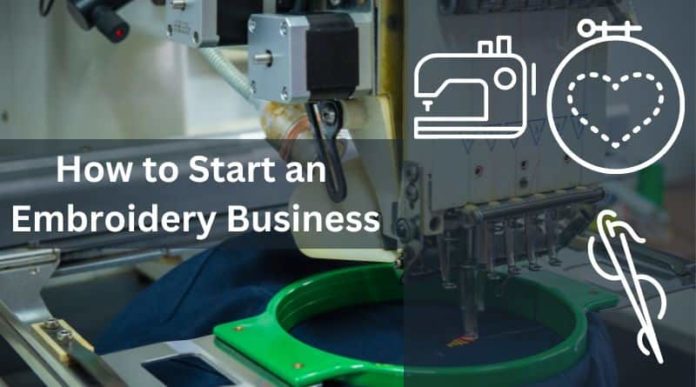Are you thinking of how to start an embroidery business? If so, you’ve come to the right place. Here is the 6 steps.
How To Start An Embroidery Business: 6 Insightful Steps
- Conduct an embroidery business market research
- Analyze costs of the embroidery business
- Create a Business Plan for your embroidery business
- Fund your Embroidery business through various sources
- Make-sure online presence of your embroidery business (Marketing)
- Get Your Licenses and Permits for setting up an embroidery business
Starting an embroidery business can be an exciting and rewarding venture, but it requires careful planning and research. From assessing the market demand and costs of materials to creating a business plan and securing funding, there are many important aspects to consider when starting your embroidery business. In this blog post, we will guide you through the process of starting an embroidery business from scratch, including tips on market research, business planning, and funding options. Whether you’re an experienced embroiderer or just getting started, this guide will provide you with the knowledge and tools you need to turn your passion into a successful business. So let’s get started.
An Embroidery Business: Short Sketch

An embroidery business is a unique business that involves using a needle and thread to create intricate designs and patterns on fabrics. The embroidery industry has been around for centuries and continues to be an important part of the fashion industry today. An embroidery business is a creative venture that can be both rewarding and profitable.
Starting an embroidery business requires a lot of research and planning. The first step is to determine the type of embroidery services you will offer, as well as your target customer base. It is important to understand the needs and preferences of your potential clients in order to create products and services that meet their needs. Once you have established a target customer base, you can begin to determine the types of fabrics, threads, needles, and other materials you will need to provide your services.
In addition to the physical materials required to operate an embroidery business, there are also certain software programs that you will need to purchase in order to design and digitize your artwork. There are several different embroidery software programs available, so it is important to do your research and find the one that best suits your needs.
When starting an embroidery business, it is also important to create an online presence in order to reach more potential customers. Creating a website, utilizing social media platforms, and engaging in online advertising are all excellent ways to promote your business. Additionally, creating an online portfolio of your work can help prospective customers see what you are capable of producing.
Overall, starting an embroidery business is a creative venture that has the potential to be lucrative and rewarding. With the right amount of research, planning, and dedication, anyone can start their own successful embroidery business. Following are the necessary steps to learn about “how to start an embroidery business.
Step 1: Conduct An Embroidery Business Market Research

Conducting market research is an essential part of starting an embroidery business. This research will help you identify your target audience, assess the level of competition in the industry, and identify potential customers. Here are some tips on how to conduct effective market research for an embroidery business.
Identifying Target Audience:
Identifying your target audience is key to launching a successful embroidery business. Your target audience will determine the products and services you offer, as well as the marketing strategies you use. Ask yourself who are your customers and what do they want?
Assessing Market Competition:
Knowing who your competitors are is essential when it comes to setting up an embroidery business. Take a look at the competition in the industry and evaluate their prices, products and services, and customer service. By researching their tactics, you can better position your business to compete.
Identifying Potential Customers:
Once you have identified your target audience and assessed the level of competition in the industry, you should begin identifying potential customers. Use surveys and focus groups to learn more about your customers’ preferences and needs. You can also consider utilizing social media platforms to increase awareness about your business.
Having a clear understanding of the embroidery industry and its customers is critical to the success of an embroidery business. Doing thorough market research will help you create a successful plan for your business and position it for long-term growth and success.
Step 2: Analyze Costs Of The Embroidery Business
Starting an embroidery business requires the entrepreneur to understand the financial side of the business. Knowing the costs and potential earnings from an embroidery business is critical to success. Before starting your business, it’s important to understand how much it will cost and how much you can earn.
Make Costs Estimation:
To get an accurate estimate of the start-up costs for an embroidery business, you must first determine what products or services you will offer. Depending on your offerings, you may need to invest in a wide range of products and services, such as special thread, fabric, needles, machines, software, and other necessary tools. Other items you may need include furniture and equipment for your workspace, marketing materials, and any required business licenses or permits. The cost of these items can add up quickly, so it’s important to have a detailed budget and plan before you start.
Estimate Your Earnings:
Once you have calculated your start-up costs, you should also consider how much you can earn from an embroidery business. Your profits will depend on factors such as the complexity of your designs, the quality of your supplies, and the demand for custom embroidery. It is important to research the market in your area to determine the pricing structure that works best for you and your business.
By taking the time to analyze the costs associated with starting an embroidery business, you can make sure you have the resources you need to get started and become successful. With proper planning and a clear understanding of the financials of your business, you can set yourself up for success.
Step 3: Create A Business Plan For Your Embroidery Business
A business plan is the most important document for an embroidery business. It serves as a roadmap, helping you to stay organized and focused on your goals. It also helps you attract potential investors and partners, as well as giving you a clear idea of how to get started in the embroidery industry.
Executive Summary:
When creating your business plan, it’s important to consider all aspects of the embroidery business, from the services you will offer to the cost of materials and equipment. Your plan should include detailed financial projections, including start-up costs and projected income. It should also include a marketing plan and a strategy for online presence in embroidery businesses. Additionally, make sure that the plan includes a timeline for reaching milestones in your business.
Management Team:
Creating a comprehensive business plan is no easy task, but it’s essential if you want your embroidery business to succeed. Working with a professional business consultant or accountant can be extremely beneficial in this process. Not only will they help you create a thorough plan, they will also provide valuable insight into the embroidery industry. In the end, the effort will be worth it, as having a well-developed business plan is one of the best investments you can make in your embroidery business.
Financial Plan:
Financial planning for three years, including startup expenses, break-even analysis, profit and loss projections, cash flow, and a balance sheet
Step 4: Fund Your Embroidery Business Through Various Sources
Starting an embroidery business can be a complex and expensive process, especially when you’re trying to cover all the bases. Fortunately, there are a variety of funding sources available to help entrepreneurs bring their embroidery businesses to life. Whether you’re looking for a bank loan, government grant, capital venture, or assistance from family and friends, these sources can provide the funds you need to get your embroidery business up and running.
Bank Loans:
Bank loans are one of the most common funding sources for starting an embroidery business. A small business loan can provide the necessary capital to purchase equipment and supplies, hire staff, and cover other costs associated with starting a business. In order to qualify for a loan, you’ll need to provide the bank with a detailed business plan outlining the scope of your embroidery business, as well as a detailed breakdown of expected costs.
Capital Ventures:
Capital ventures are another option for those seeking to fund their embroidery businesses. These venture capitalists provide capital to entrepreneurs in exchange for a stake in the company. It’s important to note that venture capitalists typically require extensive due diligence and may even require a portion of the company’s ownership.
Government Grants:
Government grants can also be a great source of funding for entrepreneurs in the embroidery industry. In addition to providing financial assistance, these grants can often provide mentoring, technical assistance, and access to other resources that can help launch an embroidery business.
Family And Friends:
Family and friends may also be willing to provide financial assistance in the form of a loan or investment. This is especially helpful if you don’t have access to traditional funding sources. However, it’s important to make sure that your family and friends are aware of the risks associated with investing in a startup business, as they could potentially lose their money if the business fails.
Step 5: Make-Sure Online Presence Of Your Embroidery Business (Marketing)
An online presence is absolutely crucial for an embroidery business. Having a website and using various forms of social media is essential for marketing your business, as well as providing customers with an easy way to learn more about your products and services. You can also use digital platforms such as Etsy or Shopify to set up an online store to sell your embroidered items.
Professional Website:
Make sure that your website is up-to-date with your latest products and services, and that it reflects the quality of your embroidery. Also, consider investing in SEO (Search Engine Optimization) techniques to help potential customers find your website more easily.
Social Media:
Social media is another important tool for marketing an embroidery business. Platforms like Instagram, Facebook, and Twitter are great places to post pictures of your latest designs and encourage customers to share their feedback. You can also use other digital marketing tools such as email campaigns, online ads, and video content to promote your embroidery business.
Online presence is key for any successful embroidery industry. Make sure to invest in a well-designed website, engaging social media presence, and digital marketing strategies to ensure your business has a presence online.
Step 6: Get Your Licenses And Permits For Setting Up An Embroidery Business
Depending on your state, this may include a business license, a sales tax permit and/or a resale permit. Additionally, you will need to consider any permits or licensing requirements related to the embroidery industry that may exist in your area.
The specific licenses and permits you’ll need will depend on your location and the type of embroidery work you’ll be doing. For example, you may need a general business license, a sales tax permit, or a zoning permit. Additionally, if you plan to embroider certain types of products, such as children’s clothing or medical devices, you may need to obtain specialized permits or certifications. To ensure that you’re meeting all the legal requirements for your business, it’s a good idea to research the regulations in your area and consult with a local business attorney or accountant.
Lastly, it is important to make sure that you have all the necessary legal documents for your business. This includes any contracts that may be required to do business with other companies or individuals. It is also important to have liability insurance coverage in case of any accidents that may occur during production or delivery of your products. Having all of your legal documents in order is essential for running an effective and compliant embroidery business.
Frequently Asked Question (FAQs) about setting up an embroidery business.
1) How much does it cost to start an embroidery business?
The cost of starting an embroidery business can vary greatly depending on factors such as the size of the business, the type of embroidery equipment and supplies needed, and the location. However, some of the basic costs that you will need to consider include purchasing an embroidery machine (which can cost anywhere from a few hundred dollars to several thousand dollars), thread and stabilizers, digitizing software, a computer, and a workspace.
You may also need to budget for additional expenses such as business licenses and permits, marketing materials, and insurance. To get a more accurate idea of the costs involved in starting an embroidery business, it’s a good idea to create a detailed business plan and consult with industry experts or a business advisor.
2) What type of research should I do before starting an embroidery business?
Before starting an embroidery business, it’s important to conduct several types of research to ensure that your business is successful. This research includes market research to identify your target market, assess the demand for embroidery services in your area, and analyze your competition. You should also conduct industry research to learn about the latest trends and technologies in the embroidery industry and the best practices for managing an embroidery business.
3) Why is online presence important for an embroidery business?
In today’s digital age, an online presence is crucial for any embroidery business. Having a website and social media accounts can increase visibility and attract new customers. It also adds credibility and helps establish and reinforce your brand, which can help differentiate your business from competitors. An online presence provides a platform for marketing your embroidery business, showcasing your work, and offering promotions and discounts.
Additionally, it provides a means for communicating with customers, improving customer service, and building trust. Overall, an online presence is essential for the success of an embroidery business in today’s competitive market.
4) What licenses and permits do I need for my embroidery business?
To operate an embroidery business, you may need to obtain various licenses and permits depending on your location and type of business. Some common licenses and permits include a general business license, sales tax permit, zoning permit, specialized health and safety permits, and environmental permits. It’s important to research the specific requirements in your area and consult with a local business attorney or accountant to ensure that you’re meeting all the legal requirements for your embroidery business.
Conclusion
Starting an embroidery business can be a challenging endeavor. You must conduct extensive research into the industry, determine the costs of starting and operating your business, create a business plan, secure funding, and obtain all the necessary licenses and permits. Once you have completed all of these steps, you should make sure that your business has a strong online presence in order to reach the largest possible audience. With the right combination of planning and hard work, you can be successful in launching an embroidery business and thrive in this growing industry.
Now you have a clear idea about “how to start an embroidery business”, so gear up and get to work. Feel free to shoot us a message if you have any concerns regarding your business, we would love to assist.

